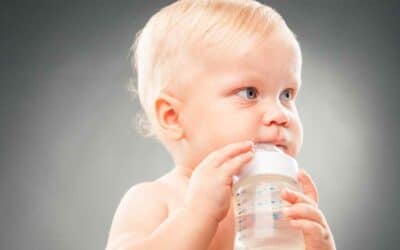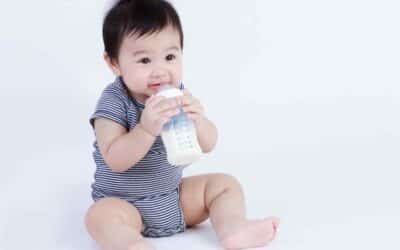One of the essential tasks that parents do is to ensure their babies receive proper nutrition to promote optimum growth. While many parents prefer breast milk, others prefer infant formula feeding. Infant formula is an excellent option for babies who are unable to breastfeed or are supplementing with infant formula, it’s still best to learn a few techniques for preparing and storing formula to keep your little one safe and healthy.
If you’re one of the many parents still trying to figure out the basics of preparing infant formula, don’t fret. This article will provide a step-by-step guide to safely storing and preparing formula products and helpful tips to ensure your baby gets the most out of powdered formula when feeding your baby. Let’s get started.

Choosing the Right Infant Formula for Your Baby
When it comes to formula feeding, choosing the right formula for your baby is crucial. And with the many types of infant formula available, selecting the best one can be challenging. Aside from cow’s milk-based, soy-based, and specialized infant formula products are available for infants depending on their dietary needs. Here are some factors to consider when choosing the right infant formula for your baby:
Age: Most infant formula products use special formulations based on the baby’s different stages of development. For instance, infant formula products are formulated for newborns, while others have ingredients for older infants.
Nutritional Needs: Besides your baby’s age, you must also consider your baby’s nutritional needs when choosing powdered infant formula. Does your baby have any special dietary requirements or health concerns that may require a specialized formula? Considering your baby’s nutritional needs is crucial, especially when they have a weakened immune system.
Allergies or Intolerances: You can also consider your baby’s allergies or intolerances to specific ingredients. If your baby has any allergies, then it’s best to choose a specialized formula that doesn’t contain any ingredients that might trigger them.
Price: Another factor that you may consider is the price. Formula products like concentrated formula can be expensive. So, if a particular powdered formula is out of your budget, then it’s best to choose another one.
Brand Reputation: Lastly, consider your brand’s reputation when choosing a formula to feed your baby. It’s highly advisable to look for a brand that many healthcare professionals and other parents trust.
Discussing the Primary Types of Baby Formula

Three primary types of baby formula are available: cow’s milk-based, soy-based, and specialized. Here’s a closer look at each type:
Cow’s Milk-Based Formula
This powdered infant formula is made from cow’s milk that has been modified to make it more easily digestible for infants. Most babies do well on cow’s milk-based formula, which is also the most commonly used type of formula. However, some babies may be allergic to cow’s milk-based formula or have trouble digesting it.
Soy-Based Powder Formula
Another option that you can consider is a soy-based powder formula. It’s an excellent option for babies who have allergies to cow’s milk-based formula or have challenges digesting it. However, same with the previous powder formula type on the list, there are instances when some babies may be allergic to soy-based formula.
Specialized Formula
Various types of specialized baby formula products are available in the market these days besides powdered formula. One of them is a hypoallergenic formula, which has a specialized formulation designed for babies with intolerances to cow’s milk protein. There are also mixed formula products designed for lactose intolerant babies and those born prematurely and need specially formulated nutrients for their growth.
How to Make a Bottle of Ready-to-Use formula
Step 1: Keep Your Hands Sanitized
Wash your hands thoroughly before handling the bottle and your baby’s ready-to-feed formula. Doing so will help to prevent the spread of germs and keeps your baby safe and healthy. Thus, making it an effective disease control method at home.
Step 2: Shake the Ready-to-use Formula Bottle
It’s essential to mix formula products well before opening them. It’s an effective way to ensure the formula is mixed well and ready to be fed to your baby during infant formula preparation.
Step 3: Only Use a Sterilized Baby Bottle
Pour the desired formula into a clean, sterilized baby bottle. Check the label on the ready-to-use formula bottle to ensure you give your baby the correct formula powder.
Step 4: Check the Temperature of the Formula
It’s highly advisable to check the formula before giving it to your baby. You can do so by dropping a few drops on your wrist. The formula should feel warm but not hot and close to your body temperature. You can also use a bottle warmer or warm water to warm the formula, but never use a microwave, as it can create hot spots that can burn your baby.
Step 5: Screw the Nipple Onto the Bottle
Always check to see if the nipple is tightly screwed onto the bottle to prevent leaks. You may also test the flow of the formula so that your baby won’t get drenched as your baby drinks. The formula should drip slowly from the nipple. If the flow is too slow or too fast, adjust the nipple accordingly.
Step 6: Hold The Baby Formula Upright
You must hold your baby upright in your baby’s mouth when trying to feed your baby with your prepared formula. Doing so helps to prevent your baby from choking and helps the formula flow smoothly into their stomach.
Step 7: Get Rid of Any Remaining Formula
If your baby does not finish the bottle, discard any remaining formula. A ready-to-use formula cannot be stored and must be used within an hour after opening.
Practical Tips for Feeding Your Infant- Prepared Formula

Whether you’re providing breast milk for your child or prefer to provide some prepared formula for your little bundle of joy, it’s vital to ensure that your baby gets the right amount of nutrition they need to grow and thrive. So, to make it easier, here are a few tips to help you get started:
Choose the Right Equipment
If you prefer ready-to-feed formula or liquid concentrate formula, it’s essential to choose the right baby’s bottle and nipple based on your baby’s age and feeding needs. For instance, newborns may need a slower-flow nipple, while older infants may need a faster-flow nipple.
Ensure Proper Formula Temperature
For parents and guardians who are formula feeding, ensure that you warm bottles and let them cool before feeding your baby. To test the temperature and determine if the baby’s formula is ready for consumption, it’s essential to test the temperature before giving it to your baby. You can put a few drops of the warmed formula on your wrists to determine if it’s at the right temperature. If not, you can run it through tap water or an ice bath to reduce the temperature. Another way to warm formula products is by using bottle warmers.
Avoid Any Air Bubbles
When formula feeding your baby, it’s important to tap the bottom of the bottle to remove any air bubbles before feeding your baby. Remember that air bubbles can cause your baby to become gassy and uncomfortable. So, it’s best to be mindful about your
Learn to Read Your Baby’s Fullness Cues
It’s also important to watch for signs of fullness when feeding your baby with formula powder mixed with warm water. It can be as simple as turning away from the breast milk or bottle or even closing their mouth when you’re attempting to put the bottle gently into his or her mouth.
Feed Only When Hungry
Giving your baby ready-to-feed formula is essential when showing signs of hunger. It can be rooting, crying, or sucking on their fists.
Conclusion
Safely preparing and storing formula for infants is essential for their health and well-being. Following the steps outlined in this article, including choosing the right formula and equipment, properly preparing and storing formula, and feeding your infant safely, ensure your little one gets the nutrition they need to grow and thrive.
Also, always wash your hands and equipment thoroughly, measure formula and water accurately, and store the formula properly in the refrigerator or freezer. Also, consult your pediatrician if you have any questions or concerns about feeding your baby formula. With these tips, you can rest assured that you’re doing everything possible to keep your baby safe and healthy.
If you have any questions or concerns, don’t hesitate to ask. Leave a comment below.



